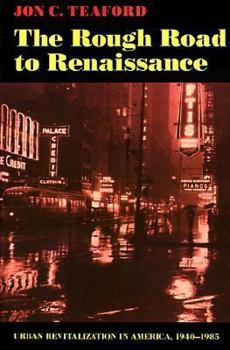The Rough Road to Renaissance: Urban Revitalization in America, 1940-1985
(Part of the Creating the North American Landscape Series)
Select Format
Select Condition 
Book Overview
After prospering in the nineteenth and early twentieth centuries, America's great urban centers faced economic, demographic, and political decline during the depression of the 1930s. When the Second World War brought economic recovery, politicians and planners of the 1940s confidently anticipated a new golden age for big cities. But the postwar boom never came, and urban America has been waiting for the "renaissance" ever since. In"The Rough Road...
Format:Paperback
Language:English
ISBN:0801841348
ISBN13:9780801841347
Release Date:August 1990
Publisher:Johns Hopkins University Press
Length:408 Pages
Weight:1.41 lbs.
Dimensions:1.1" x 6.0" x 9.1"
Customer Reviews
1 rating
The only thing missing is the ?why.
Published by Thriftbooks.com User , 27 years ago
Analysis of Jon C. Teaford's The Rough Road to Renaissance: Urban Revitalization in America, 1940-1985 The Rough Road to Renaissance is a chronicle of the urban revitalization efforts of several older central cities in the Northeastern United States from World War II to the mid 1980s. As the author reveals, these efforts were fraught with difficulties from the very beginning, but usually not from a lack of planning or enthusiasm. According to Teaford, "this study charts the treacherous course toward the seemingly elusive goal of urban renaissance" (Teaford, 2). The body of the work is a discussion of the techniques that city leaders used to stop the "blight" of the urban centers. Teaford divides these strategies into a number of historical stages based on renewal tactics and support for revitalization programs. The first stage in the story of urban renewal occurred during World War II, which was the realization that a problem existed in America's aging cities. Census figures revealed that the population in older urban areas was beginning to decline resulting from the increased migration to suburbia. City planners believed that the best way to combat urban decline and slow migration to the suburbs was by become more like them. With the war's end came the opportunity for enthusiastic city planners to test their renewal schemes. Because the post-war economy did not fall into the collapse that they had anticipated, plans for massive public works projects and federal support were stalled. Planners were forced to seek support from inside the metropolitan area through the installation of public officials dedicated to the cause, development of a solid fiscal base for redevelopment, and "massing the clout of big business behind renewal efforts" (Teaford, 45). By the 1950s, most older central cities had joined the urban renewal bandwagon. Because many planners believed that their cities simply needed a facelift, most revitalization efforts concentrated on creating a modern and clean urban image. Sewer and water treatment plants were constructed to clean up the environment and freeway systems and airports were built to bring the city up to the "automobile age." Instead of slowing suburban migration both of these tactics actually encouraged it. But planners were not yet disheartened, for failure had brought valuable lessons. "During the late 1940s and the early 1950s, America's aging cities may not have eradicated their slums or achieved their dreams of renewal, but they had experimented with redevelopment and rehabilitation and prepared the ground for more massive projects of the future" (Teaford, 120). Unfortunately, urban decline only accelerated in the following decades. Despite attempts at renewal, even more wealthy and middle class whites were washed out to the suburbs as poor minorities flooded in to the central city. Urban sales plummeted and manufacturing jobs disappeared. "By the early 1960s prudent observers per





